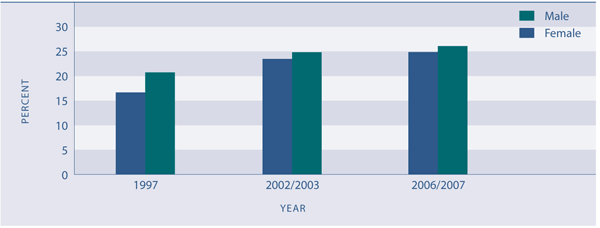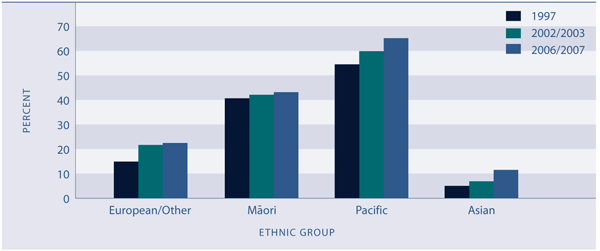Obesity
Definition
The proportion of the population aged 15 years and over who are obese, and the proportion of children aged 5–14 years who are obese.
For adults aged 18 years and over, obesity is defined as having a body mass index (BMI) greater than or equal to 30 kg/m2 (for all ethnic groups). 35 For those under 18 years, internationally defined sex and age specific BMI cut-off points have been used. 36
Relevance
Obesity is associated with a long list of adult health conditions, including heart disease, high blood pressure and strokes, type 2 diabetes, various types of cancer, and psychological and social problems. Obese children are likely to be obese into adulthood.37
Current level and trends
In 2006/2007, the age-standardised obesity prevalence rate for the population aged 15 years and over was 25 percent. This was similar to the 2002/2003 rate of 24 percent but a significant increase from the 1997 rate of 19 percent.38
In 2006/2007, 8 percent of children aged 5–14 years were obese, a prevalence rate similar to that of 2002 (9 percent).39
The major drivers of the increase in obesity rates have been changing dietary and physical activity patterns, reflecting an environment that promotes the overconsumption of energy-dense foods and drinks and limits the opportunities for physical activity.40
Figure H5.1 Age-standardised prevalence of obesity, total population aged 15 years and over, by sex, 1997, 2002/2003 and 2006/2007

Source: Ministry of Health, Public Health Intelligence
Age and sex differences
Age-standardised prevalence rates for 2006/2007 showed no significant sex difference in the proportion of the population aged 15 years and over who were obese (males, 25 percent; females, 26 percent). This was also the case in 2002/2003. In 1997, the age-standardised rate for females was significantly higher than the rate for males.
Among children aged 5–14 years, there was no significant difference by sex or age in the prevalence of obesity, either in 2002 or in 2006/2007.
Among those aged 15 years and over in 2006/2007, the prevalence of obesity was highest in the 55–64 years age group (36 percent), followed by the 65–74 years age group.
Table H5.1 Prevalence (%) of obesity, by age group and sex, 2006/2007
| |
5–14 |
15–24 |
25–34 |
35–44 |
45–54 |
55–64 |
65–74 |
75+ |
| Males |
8.1 |
12.7 |
22.2 |
29.9 |
30.8 |
35.9 |
29.9 |
21.7 |
| Females |
8.6 |
15.7 |
26.6 |
26.9 |
30.2 |
35.9 |
35.7 |
20.1 |
| Total |
8.3 |
14.2 |
24.4 |
28.4 |
30.5 |
35.9 |
32.8 |
20.8 |
Source: Ministry of Health, Public Health Intelligence
Ethnic differences
There are large differences in the prevalence of obesity by ethnicity. Among the population aged 15 years and over in 2006/2007, Pacific peoples (65 percent) and Māori (43 percent) had significantly higher age-standardised obesity rates than the total population in this age group, while Asians (12 percent) had a significantly lower rate. The obesity rate of European/Other was (23 percent). For Māori, there was no significant change from 1997 to 2006/2007 in the prevalence of obesity, adjusted for age, either for men or for women. Between 2002/2003 and 2006/2007, only Asians had a statistically significant increase in obesity.
Among children aged 5–14 years in 2006/2007, the pattern of ethnic differences in the prevalence of obesity was similar to that of the population aged 15 years and over. Pacific children had the highest rate (26 percent), followed by Māori children (13 percent), Asian children (6 percent) and children of European/Other ethnic groups (5 percent).
Figure H5.2 Age-standardised prevalence of obesity, population aged 15 years and over, by ethnic group, 1997, 2002/2003, 2006/2007

Source: Ministry of Health, Public Health Intelligence
Note: People who reported more than one ethnic group are counted once in each group reported
Socio-economic differences
The prevalence of obesity is higher in relatively deprived neighbourhoods.
In 2006/2007, 38 percent of the population aged 15 years and over living in NZDep2006 quintile 5 (the most disadvantaged fifth of neighbourhoods) were obese, compared with 26 percent of those living in quintile 4, 23 percent of those living in quintile 3 and 21 percent of those living in quintiles 1 and 2.
International comparison
New Zealand has a relatively high prevalence of obesity compared with other OECD countries. In 2006/2007, New Zealand’s rate was 25 percent, compared to an OECD median of 13 percent. New Zealand was ranked 28th out of 30 OECD countries reporting obesity prevalence from 1999–2006. However, most countries use the self-reporting method to measure obesity whereas New Zealand and five other countries use actual measurements recorded by an interviewer.41 Out of the six countries that use actual measurements, New Zealand was ranked second highest with a lower obesity rate than the United States (34 percent in 2006), and a similar rate to the United Kingdom (24 percent in 2006) and Australia (22 percent in 1999). Of all OECD countries, Japan and Korea had the lowest prevalence of obesity (both 4 percent in 2005).42
|


